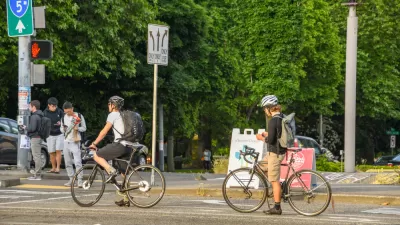Joseph Stromberg discusses the "Idaho Stop"—so named because Idaho has been allowing bikers to roll through stop signs since 1982.
"Idaho's rule is pretty straightforward," writes Joseph Stromberg, "[if] a cyclist approaches a stop sign, he or she needs to slow down and look for traffic. If there's already a pedestrian, car, or another bike there, then the other vehicle has the right of way. If there's no traffic, however, the cyclist can slowly proceed. Basically, for bikers, a stop sign is a yield sign." Additonally, bikers approaching a red light must stop, but if there is no oncoming traffic, the biker can treat the light as a stop sign, and proceed through the intersection.
After acknowledging that the Idaho Stop has not been adopted by many other locations—as well as detailing the simple physics problem that compels many bikers to choose not to stop—Stromberg goes on to examine research suggesting that the Idaho Stop is not any less safe than the more common alternative: "Public health researcher Jason Meggs found that after Idaho started allowing bikers to do this in 1982, injuries resulting from bicycle accidents dropped. When he compared recent census data from Boise to Bakersfield and Sacramento, California — relatively similar-sized cities with comparable percentages of bikers, topographies, precipitation patterns, and street layouts — he found that Sacramento had 30.5 percent more accidents per bike commuter and Bakersfield had 150 percent more."
Stromberg also makes a couple additional, less scientific, arguments in favor of allowing Idaho Stops.
FULL STORY: Why cyclists should be able to roll through stop signs and ride through red lights

Planetizen Federal Action Tracker
A weekly monitor of how Trump’s orders and actions are impacting planners and planning in America.

Map: Where Senate Republicans Want to Sell Your Public Lands
For public land advocates, the Senate Republicans’ proposal to sell millions of acres of public land in the West is “the biggest fight of their careers.”

Restaurant Patios Were a Pandemic Win — Why Were They so Hard to Keep?
Social distancing requirements and changes in travel patterns prompted cities to pilot new uses for street and sidewalk space. Then it got complicated.

Platform Pilsner: Vancouver Transit Agency Releases... a Beer?
TransLink will receive a portion of every sale of the four-pack.

Toronto Weighs Cheaper Transit, Parking Hikes for Major Events
Special event rates would take effect during large festivals, sports games and concerts to ‘discourage driving, manage congestion and free up space for transit.”

Berlin to Consider Car-Free Zone Larger Than Manhattan
The area bound by the 22-mile Ringbahn would still allow 12 uses of a private automobile per year per person, and several other exemptions.
Urban Design for Planners 1: Software Tools
This six-course series explores essential urban design concepts using open source software and equips planners with the tools they need to participate fully in the urban design process.
Planning for Universal Design
Learn the tools for implementing Universal Design in planning regulations.
Heyer Gruel & Associates PA
JM Goldson LLC
Custer County Colorado
City of Camden Redevelopment Agency
City of Astoria
Transportation Research & Education Center (TREC) at Portland State University
Camden Redevelopment Agency
City of Claremont
Municipality of Princeton (NJ)





























